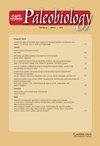Reassessing growth and mortality estimates for the Ordovician trilobite Triarthrus eatoni
IF 2.6
2区 地球科学
Q2 BIODIVERSITY CONSERVATION
引用次数: 3
Abstract
Abstract. A length–frequency sample (n = 295) from a fossil population of the Ordovician trilobite Triarthrus eatoni Hall, 1838, assembled and analyzed by J. L. Cisne in 1973 is here reexamined using methods of length–frequency analysis commonly used in fishery science and marine biology. Theoretical considerations and the empirical data at hand suggest that the growth of T. eatoni was not “linear,” but asymptotic, as is the growth of most Recent marine invertebrates. The parameters of the von Bertalanffy growth function (L ∞ = 41 mm, K = 0.29 yr–1) suggest that T. eatoni, which apparently lived in a challenging environment, grew somewhat more slowly than the extant marine isopod Ceratoserolis trilobitoides (Eights, 1833), used here as Recent analogue to T. eatoni. This trilobite probably lived up to 10 years, rather than the suggested 4 years, and its mortality rate was 15%–20% per year rather than 30%–40% per year. These represent the first estimates of trilobite absolute growth characteristics using methods known to accurately model growth in extant water-breathing ectotherms. These provide a baseline for trilobite growth that can be used to make inferences about growth in other species. The approach used here may also be applied to other trilobites for which suitable length–frequency data exist.奥陶系三叶虫Triarthrus etoni的生长和死亡率估算
摘要本文使用渔业科学和海洋生物学中常用的长度-频率分析方法,对J.L.Cisne于1973年组装和分析的奥陶纪三叶虫Triarthrus eatoni Hall(1838)化石种群的长度-频度样本(n=295)进行了重新检查。理论考虑和手头的经验数据表明,T.eatoni的生长不是“线性的”,而是渐进的,就像最近海洋无脊椎动物的生长一样。von Bertalanffy生长函数的参数(L∞=41 mm,K=0.29 yr–1)表明,显然生活在充满挑战的环境中的T.eatoni的生长速度比现存的海洋等足类三叶虫Ceratosolis trilobitoides(Eights,1833)稍慢,后者在这里被用作T.eatoni的最近类似物。这种三叶虫的寿命可能长达10年,而不是建议的4年,其死亡率为每年15%-20%,而不是每年30%-40%。这些代表了首次使用已知方法对三叶虫的绝对生长特性进行估计,以准确模拟现存的水呼吸外胚层的生长。这些为三叶虫的生长提供了基线,可以用来推断其他物种的生长。这里使用的方法也可以应用于存在合适长度-频率数据的其他三叶虫。
本文章由计算机程序翻译,如有差异,请以英文原文为准。
求助全文
约1分钟内获得全文
求助全文
来源期刊

Paleobiology
地学-古生物学
CiteScore
5.30
自引率
3.70%
发文量
38
审稿时长
>12 weeks
期刊介绍:
Paleobiology publishes original contributions of any length (but normally 10-50 manuscript pages) dealing with any aspect of biological paleontology. Emphasis is placed on biological or paleobiological processes and patterns, including macroevolution, extinction, diversification, speciation, functional morphology, bio-geography, phylogeny, paleoecology, molecular paleontology, taphonomy, natural selection and patterns of variation, abundance, and distribution in space and time, among others. Taxonomic papers are welcome if they have significant and broad applications. Papers concerning research on recent organisms and systems are appropriate if they are of particular interest to paleontologists. Papers should typically interest readers from more than one specialty. Proposals for symposium volumes should be discussed in advance with the editors.
 求助内容:
求助内容: 应助结果提醒方式:
应助结果提醒方式:


